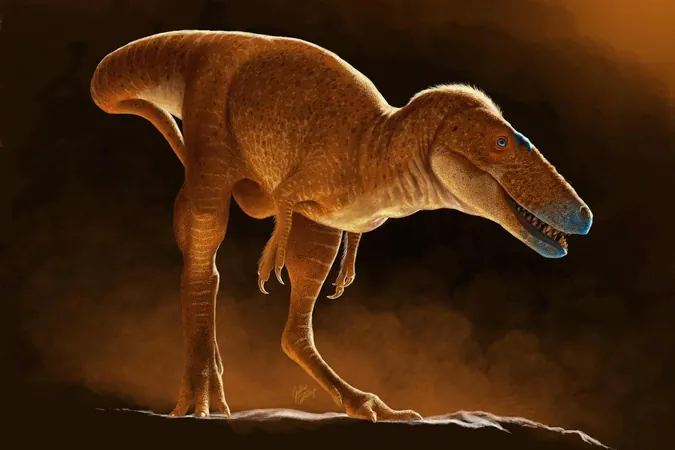
Discover the 'Dragon Prince': The Dinosaur That Predated T. rex!
2025-06-11
Author: Mei
Meet the 'Dragon Prince'—A Prehistoric Marvel!
A mesmerizing new discovery from the deserts of Mongolia reveals a mid-sized dinosaur nicknamed the "Dragon Prince"—an evolutionary forerunner to none other than the Tyrannosaurus rex! This groundbreaking find not only uncovers the complex family tree of the iconic predator but also sheds light on the fascinating history of dinosaurs.
Introducing Khankhuuluu mongoliensis!
Officially known as Khankhuuluu mongoliensis (pronounced khan-KOO-loo mon-gol-ee-EN-sis), this intriguing dinosaur roamed the Earth approximately 86 million years ago during the Cretaceous Period. Predating T. rex by a whopping 20 million years, Khankhuuluu represents a crucial branch in the tyrannosaur lineage, which produced some of the largest carnivorous creatures ever to walk the planet.
How Big Was the 'Dragon Prince'?
At about 13 feet (4 meters) in length and weighing around 1,600 pounds (750 kg), Khankhuuluu was a lithe predator, built for speed and agility. While it was smaller and more lightly constructed than the formidable T. rex, its lengthy snout and serrated teeth reveal that it was well-equipped for chasing down lighter prey such as bird-like dinosaurs known as oviraptorosaurs and ornithomimosaurs.
From Prince to King: The Name Says It All!
The name "Khankhuuluu" translates to "Dragon Prince" in Mongolian, aptly reflecting its status as a precursor to the fearsome T. rex, which means "tyrant king of the lizards." As paleontologist Darla Zelenitsky from the University of Calgary puts it, this dinosaur was still a "prince" on the evolutionary ladder, a significant yet smaller lineage waiting its turn to rule.
A Unique Transitional Beast!
Khankhuuluu is described as an almost-tyrannosaur. It possesses several anatomical features reminiscent of its colossal descendants but lacks key traits that define true tyrannosaurs. Notable differences include specialized bone structures around its snout and eyes, indicating how evolution gradually shaped the lineage into the terrifying predators we recognize today.
Rewriting Dinosaur History!
The revelation of Khankhuuluu hinges on a set of well-preserved fossils unearthed back in the 1970s, which have only recently been thoroughly analyzed. This new research redefines our understanding of the tyrannosaur family's evolution, revealing that Khankhuuluu is the crucial link between smaller ancestors and the menacing giants that followed.
A Journey Across Continents!
According to lead author Jared Voris, the discovery highlights the origins of the tyrannosaur family in Asia. It’s believed that around 85 million years ago, these early tyrannosaurs crossed a land bridge from Siberia to North America, evolving over millions of years into apex predators. This migration illustrates how the tyrannosaurs spread and diversified, leading to the T. rex's eventual reign.
Ancestors of the Apex Predator!
Khankhuuluu serves as a captivating glimpse into the ancient world of dinosaurs—often described as a distant relative to T. rex. With each newly unveiled piece of the evolutionary puzzle, we circle closer to understanding the magnificent, complex history of these prehistoric giants.
Who Knew the Family Tree Was So Intricate?
The study of Khankhuuluu reiterates that the evolution of tyrannosaurs wasn't linear. Instead, it was a complex web of adaptations and migrations. As Zelenitsky notes, over a dozen species evolved in the 20 million years separating Khankhuuluu from its famous descendant, showcasing a vibrant evolutionary history.
The tale of the Dragon Prince is a thrilling reminder of how much we still have to learn about life on Earth before the age of dinosaurs ended in a fiery cataclysm 66 million years ago. This captivating dinosaur may just hold the key to unlocking more secrets of the Mesozoic Era!




 Brasil (PT)
Brasil (PT)
 Canada (EN)
Canada (EN)
 Chile (ES)
Chile (ES)
 Česko (CS)
Česko (CS)
 대한민국 (KO)
대한민국 (KO)
 España (ES)
España (ES)
 France (FR)
France (FR)
 Hong Kong (EN)
Hong Kong (EN)
 Italia (IT)
Italia (IT)
 日本 (JA)
日本 (JA)
 Magyarország (HU)
Magyarország (HU)
 Norge (NO)
Norge (NO)
 Polska (PL)
Polska (PL)
 Schweiz (DE)
Schweiz (DE)
 Singapore (EN)
Singapore (EN)
 Sverige (SV)
Sverige (SV)
 Suomi (FI)
Suomi (FI)
 Türkiye (TR)
Türkiye (TR)
 الإمارات العربية المتحدة (AR)
الإمارات العربية المتحدة (AR)